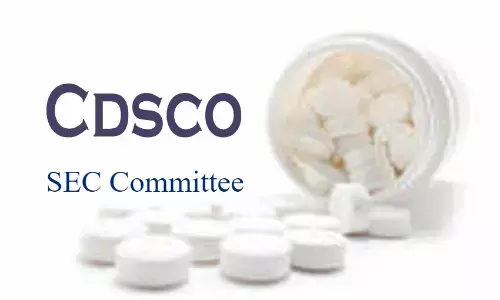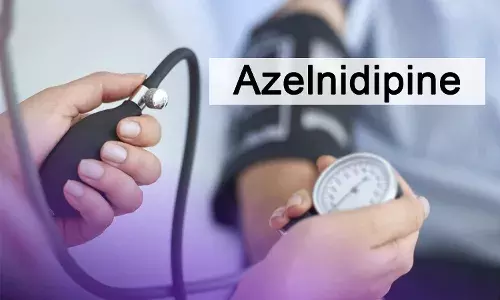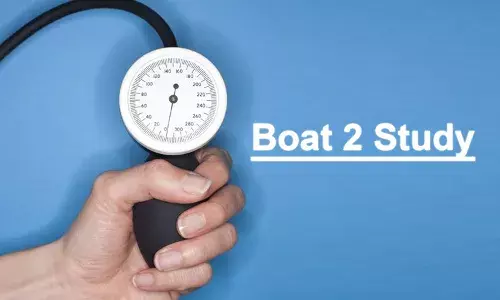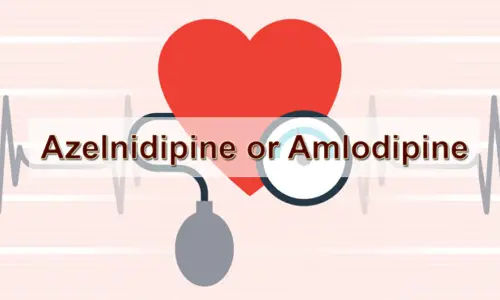- Home
- Medical news & Guidelines
- Anesthesiology
- Cardiology and CTVS
- Critical Care
- Dentistry
- Dermatology
- Diabetes and Endocrinology
- ENT
- Gastroenterology
- Medicine
- Nephrology
- Neurology
- Obstretics-Gynaecology
- Oncology
- Ophthalmology
- Orthopaedics
- Pediatrics-Neonatology
- Psychiatry
- Pulmonology
- Radiology
- Surgery
- Urology
- Laboratory Medicine
- Diet
- Nursing
- Paramedical
- Physiotherapy
- Health news
- Fact Check
- Bone Health Fact Check
- Brain Health Fact Check
- Cancer Related Fact Check
- Child Care Fact Check
- Dental and oral health fact check
- Diabetes and metabolic health fact check
- Diet and Nutrition Fact Check
- Eye and ENT Care Fact Check
- Fitness fact check
- Gut health fact check
- Heart health fact check
- Kidney health fact check
- Medical education fact check
- Men's health fact check
- Respiratory fact check
- Skin and hair care fact check
- Vaccine and Immunization fact check
- Women's health fact check
- AYUSH
- State News
- Andaman and Nicobar Islands
- Andhra Pradesh
- Arunachal Pradesh
- Assam
- Bihar
- Chandigarh
- Chattisgarh
- Dadra and Nagar Haveli
- Daman and Diu
- Delhi
- Goa
- Gujarat
- Haryana
- Himachal Pradesh
- Jammu & Kashmir
- Jharkhand
- Karnataka
- Kerala
- Ladakh
- Lakshadweep
- Madhya Pradesh
- Maharashtra
- Manipur
- Meghalaya
- Mizoram
- Nagaland
- Odisha
- Puducherry
- Punjab
- Rajasthan
- Sikkim
- Tamil Nadu
- Telangana
- Tripura
- Uttar Pradesh
- Uttrakhand
- West Bengal
- Medical Education
- Industry
Montair + Montair + Montair
Dosage form, Side Effects
Pain analgesics
OTC
Central Drugs Standard Control Organisation(CDSCO)
Schedule
India, china, nepal
name
Dolokind 100mg Tablet is a pain-relieving medicine. It alleviates pain and inflammation in conditions like rheumatoid arthritis, ankylosing spondylitis, and osteoarthritis.
Dolokind 100mg Tablet should be taken in the dose and duration as advised by your doctor. It should be taken with food or milk to prevent stomach upset. Taking the medicine regularly at the right times increases its effectiveness. It is important to keep taking the medicine regularly until your doctor tells you it is safe to stop.
Dolokind 100mg Tablet is a non-steroidal anti-inflammatory drugs (NSAID). It works by blocking the release of certain chemical messengers that cause pain and inflammation (redness and swelling).
How to use
Uses of "X"
Benefits of "X"
Indications of "X"
Method of administration of "X"
Dosage Form of "X"
Dosage strengths of "X"
Dietry Rescrictions & Safety Advice of X
- Dolokind is contraindicated in the following situations
- Patients sensitive to Aceclofenac, Paracetamol or to any of the excipients of the product
- Patients in whom aspirin or other NSAIDs, precipitate attacks of bronchospasm, acute rhinitis or urticaria or patients hypersensitive to these drugs
- Patients with active or suspected peptic ulcer or gastrointestinal bleeding or bleeding disorders
- Patients with severe heart failure, hypertension, hepatic or renal insufficiency
- Aceclofenac should not be prescribed during pregnancy, especially during the last trimester of pregnancy, in women attempting to conceive and during lactation unless there are compelling reasons for doing so. The lowest effective dosage should be used.
Precaution & Warnings for Using X
Alcohol Warning
AlcoholWarning
Breastfeeding Warning
reastfeedingWarning
Pregnancy Warning
Pregnancy
Food Warning
Food warning
Aceclofenac
GI: The most commonly observed adverse events are gastrointestinal in nature. Peptic ulcers, perforation or GI bleeding, sometimes fatal, particularly in the elderly, may occur. Nausea, vomiting, diarrhoea, flatulence, constipation, dyspepsia, abdominal pain, melaena, haematemesis, ulcerative stomatitis, exacerbation of colitis and Crohn's disease have been reported following administration. Less frequently, gastritis has been observed. Pancreatitis has been reported very rarely.
Hypersensitivity: Hypersensitivity reactions have been reported following treatment with NSAIDs. These may consist of (a) non-specific allergic reactions and anaphylaxis (b) respiratory tract reactivity comprising asthma, aggravated asthma, bronchospasm or dyspnoea, or (c) assorted skin disorders, including rashes of various types, pruritus, urticaria, purpura, angio-oedema and, more rarely, exfoliative and bullous dermatoses (including epidermal necrolysis and erythema multiforme).
Cardiovascular and Cerebrovascular: Oedema, hypertension and cardiac failure have been reported in association with NSAID treatment. Aceclofenac is both structurally related and metabolised to diclofenac for which a greater amount of clinical and epidemiological data consistently point towards an increased risk of general arterial thrombotic events (myocardial infarction or stroke, particularly at high doses and in long treatment). Epidemiological data has also found an increased risk of acute coronary syndrome and myocardial infarction associated with the use of aceclofenac. Exceptionally, occurrence of serious cutaneous and soft tissues infections complications during varicella has been reported in association with NSAID treatment.
Other adverse reactions reported less commonly include the following:
- Renal: interstitial nephritis
- Hepatic: abnormal liver function, hepatitis and jaundice.
- Neurological and Special Senses: optic neuritis, reports of aseptic meningitis (especially in patients with existing auto immune disorders, such as systemic lupus erythematosus, mixed connective tissue disease), with symptoms such as stiff neck, headache, nausea, vomiting, fever or disorientation confusion, hallucinations, and drowsiness.
- Haematological: agranulocytosis, aplastic anaemia.
- Dermatological: bullous reactions, including Stevens-Johnson syndrome and toxic epidermal necrolysis (very rare). Photosensitivity
If serious adverse reactions occur, aceclofenac tablets should be withdrawn
Within the system organ classes, undesirable effects are listed under headings of frequency, using the following categories: very common ((≥1/10); common (≥1/100 to <1/10); uncommon (≥1/1,000 to <1/100); rare (≥1/10,000 to <1/1,000); very rare (<1/10,000); not known (cannot be estimated from the available data). Within each frequency grouping, undesirable effects are presented in order of decreasing seriousness.
| System organ class | Common (≥1/100 to <1/10) | Uncommon (≥1/1,000 to <1/100) | Rare (≥1/10,000 to <1/1,000) | Very rare/isolated reports(<1/10,000) |
|---|---|---|---|---|
| Blood and lymphatic system disorders | Anaemia | Granulocytopaenia Thrombocytopaenia Neutropaenia Haemolytic anaemia | ||
| Immune system disorders | Anaphylactic reaction (including shock) Hypersensitivity | |||
| Metabolism and nutrition disorders | Hyperkalaemia | |||
| Psychiatric disorders | Depression Abnormal dreams Insomnia | |||
| Tremor Somnolence Headache Dysgeusia (abnormal taste) | ||||
| Eye disorders | Visual disturbance | |||
| Ear and labyrinth disorders | Vertigo Tinnitus | |||
| Cardiac disorders | Cardiac failure | Palpitations | ||
| Vascular disorders | Hypertension | Flushing Hot flush Vasculitis | ||
| Respiratory, thoracic and mediastinal disorders | Dyspnoea | Bronchospasm Stridor | ||
| GI disorders | Dyspepsia Abdominal pain Nausea Diarrhoea | Flatulence Gastritis Constipation Vomiting Mouth ulceration | Melaena GI haemorrhage GI ulceration | Stomatitis Intestinal perforation Exacerbation of Crohn's disease and Colitis Ulcerative haematemesis Pancreatitis |
| Hepatobiliary disorders | Hepatic enzyme increased | Hepatic injury (including hepatitis) Jaundice Blood alkaline phosphatase increased | ||
| Skin and subcutaneous tissue disorders | Pruritus Rash Dermatitis Urticaria | Angio-oedema | Purpura Severe mucocutaneous skin reaction (including Stevens-Johnson syndrome and toxic epidermal necrolysis) | |
| Renal and urinary disorders | Blood urea increased Blood creatinine increased | Renal failure Nephrotic syndrome | ||
| General disorders and administration site conditions | Oedema Fatigue Cramps in legs | |||
| Investigations | Weight increase |
Paracetamol
The information below lists reported adverse reactions, ranked using the following frequency classification:
Very common (≥1/10); common (≥1/100 to <1/10); uncommon (≥1/1,000 to <1/100); rare (≥1/10,000 to <1/1,000); very rare (<1/10,000); not known (cannot be estimated from the available data).
Immune System Disorders: Hypersensitivity, including skin rash may occur
NOT KNOWN: anaphylactic shock, angio-oedema.
Blood and Lymphatic System Disorders
NOT KNOWN: blood dyscrasias, including thrombocytopaenia and agranulocytosis.
Skin and Subcutaneous Disorders
Very rare cases of serious skin reactions such as toxic epidermal necrolysis, Stevens-Johnson syndrome, acute generalised exanthematous pustulosis, and fixed drug eruption have been reported.
Quinolone antibiotics: Animal data indicate that NSAIDs can increase the risk of convulsions associated with quinolone antibiotics. Patients taking NSAIDs and quinolones may have an increased risk of developing convulsions.
Anti-platelet agents and selective serotonin reuptake inhibitors (SSRIs): Increased risk of gastrointestinal bleeding.
Tacrolimus: Possible increased risk of nephrotoxicity when NSAIDs are given with tacrolimus
Zidovudine: Increased risk of haematological toxicity when NSAIDs are given with zidovudine. There is evidence of an increased risk of haemarthroses and haematoma in HIV(+) haemophiliacs receiving concurrent treatment with zidovudine and ibuprofen.
Antidiabetic agents: Clinical studies have shown that diclofenac can be given together with oral antidiabetic agents with influencing their clinical effect. However, there have been isolated reports of hypoglycaemic and hyperglycaemic effects. Thus with aceclofenac, consideration should be given to adjustment of the dosage of hypoglycaemic agents.
Anti-Coagulants: NSAIDs and Paracetamol may enhance the effects of anticoagulants, such as warfarin. Close monitoring of patients on combined anticoagulants and therapy should be undertaken
Other NSAIDs: Concomitant therapy with aspirin or other NSAIDs may increase the frequency of adverse reactions, including the risk of GI bleeding.
Paracetamol
Cholestyramine: The speed of absorption of paracetamol is reduced by cholestyramine. Therefore, the cholestyramine should not be taken within one hour if maximal analgesia is required.
Metoclopramide and Domperidone: The absorption of paracetamol is increased by metoclopramide and domperidone. However, concurrent use need not be avoided.
Chloramphenicol: Increased plasma concentration of chloramphenicol
Interaction with other medicinal products and other forms of interaction
Aceclofenac
Avoid concomitant use of two or more NSAIDs (including aspirin) as this may increase the risk of adverse effects.
Anti-Hypertensives
Reduced anti-hypertensive effect. The risk of acute renal insufficiency, which is usually reversible, may be increased in some patients with compromised renal function (e.g. dehydrated patients or elderly patients) when Angiotensin converting enzyme (ACE) inhibitors or angiotensin II receptor antagonists are combined with NSAIDs. Therefore, the combination should be administered with caution, especially in the elderly. Patients should be adequately hydrated, and consideration should be given to monitoring of renal function after initiation of concomitant therapy, and periodically thereafter.
Diuretics: Reduced diuretic effect. Diuretics can increase the risk of nephrotoxicity of NSAIDs. Although it was not shown to affect blood pressure control when co-administered with bendrofluazide, interactions with other diuretics cannot be ruled out. When concomitant administration with potassium-sparing diuretics is employed, serum potassium should be monitored.
Cardiac glycosides: NSAIDs may exacerbate cardiac failure, reduce GFR (glomerular filtration rate) and increase plasma glycoside levels.
Lithium: Decreased elimination of lithium
Methotrexate: Decreased elimination of methotrexate. Caution should be exercised if NSAIDs and methotrexate are administered within 24 hours of each other, since NSAIDs may increase plasma levels, resulting in increased toxicity.
Ciclosporin: Increased risk of nephrotoxicity.
Mifepristone: NSAIDs should not be used for 8-12 days after mifepristone administration as NSAIDs can reduce the effect of mifepristone.
Corticosteroids: Increased risk of gastrointestinal ulceration or bleeding.
Quinolone antibiotics: Animal data indicate that NSAIDs can increase the risk of convulsions associated with quinolone antibiotics. Patients taking NSAIDs and quinolones may have an increased risk of developing convulsions.
Anti-platelet agents and selective serotonin reuptake inhibitors (SSRIs): Increased risk of gastrointestinal bleeding.
Tacrolimus: Possible increased risk of nephrotoxicity when NSAIDs are given with tacrolimus
Zidovudine: Increased risk of haematological toxicity when NSAIDs are given with zidovudine. There is evidence of an increased risk of haemarthroses and haematoma in HIV(+) haemophiliacs receiving concurrent treatment with zidovudine and ibuprofen.
Antidiabetic agents: Clinical studies have shown that diclofenac can be given together with oral antidiabetic agents with influencing their clinical effect. However, there have been isolated reports of hypoglycaemic and hyperglycaemic effects. Thus with aceclofenac, consideration should be given to adjustment of the dosage of hypoglycaemic agents.
Anti-Coagulants: NSAIDs and Paracetamol may enhance the effects of anticoagulants, such as warfarin. Close monitoring of patients on combined anticoagulants and therapy should be undertaken
Other NSAIDs: Concomitant therapy with aspirin or other NSAIDs may increase the frequency of adverse reactions, including the risk of GI bleeding.
Paracetamol
Cholestyramine: The speed of absorption of paracetamol is reduced by cholestyramine. Therefore, the cholestyramine should not be taken within one hour if maximal analgesia is required.
Metoclopramide and Domperidone: The absorption of paracetamol is increased by metoclopramide and domperidone. However, concurrent use need not be avoided.
Chloramphenicol: Increased plasma concentration of chloramphenicol
Side Effects of "X"
Use of X in Specific Populations
The clinical presentation of overdose may include the signs and symptoms of aceclofenac toxicity, paracetamol toxicity or both.
Aceclofenac
SymptomsSymptoms include headache, nausea, vomiting, epigastric pain, gastrointestinal irritation, gastrointestinal bleeding, rarely diarrhoea, disorientation, excitation, coma, drowsiness, dizziness, tinnitus, hypotension, respiratory depression, fainting, occasionally convulsions. In cases of significant poisoning acute renal failure and liver damage are possible.
Therapeutic measure Patients should be treated symptomatically as required. Within one hour of ingestion of a potentially toxic amount, activated charcoal should be considered. Alternatively, in adults, gastric lavage should be considered within one hour of ingestion of a potentially life-threatening overdose. Specific therapies such as dialysis or haemoperfusion are probable of no help in eliminating NSAIDs due to their high rate of protein binding and extensive metabolism. Good urine output should be ensured. Renal and liver function should be closely monitored. Patients should be observed for at least four hours after ingestion of potentially toxic amounts. In case of frequent or prolonged convulsions, patients should be treated with intravenous diazepam. Other measures may be indicated by the patient's clinical condition. Management of acute poisoning with NSAIDs essentially consists of supportive and symptomatic measures
Paracetamol
The initial symptoms seen within the first 24 hours following an paracetamol overdose are: anorexia, nausea, vomiting, malaise, pallor and diaphoresis. In paracetamol over dosage, dose-dependent, potentially fatal hepatic necrosis is the most serious adverse effect. Renal tubular necrosis, hypoglycemic coma, and coagulation defects also may occur. Early symptoms following a potentially hepatotoxic overdose may include: nausea, vomiting, diaphoresis, and general malaise. Clinical and laboratory evidence of hepatic toxicity may not be apparent until 48 to 72 hours postingestion.
In the treatment of paracetamol over dosage, gastric decontamination with activated charcoal should be administered just prior to N-acetylcysteine (NAC) to decrease systemic absorption if paracetamol ingestion is known or suspected to have occurred within a few hours of presentation. Serum paracetamol levels should be obtained immediately if the patient presents 4 or more hours after ingestion to assess potential risk of hepatotoxicity; paracetamol levels drawn less than 4 hours post-ingestion may be misleading. To obtain the best possible outcome, NAC should be administered as soon as possible where impending or evolving liver injury is suspected. Intravenous NAC may be administered when circumstances preclude oral administration. Vigorous supportive therapy is required in severe intoxication. Procedures to limit the continuing absorption of the drug must be readily performed since the hepatic injury is dose-dependent and occurs early in the course of intoxication.
Clinical Pharmacology of X
Clinical Studies for X
Non-clinical Toxicology of X
Patient Counselling Information of X
Q. Is Dolokind 100mg Tablet a good painkiller?
Q. Is Dolokind 100mg Tablet safe?
Q. Does Dolokind 100mg Tablet get you high?
Q. Can Dolokind 100mg Tablet hurt your kidneys?
Q. What if I forget to take a dose of Dolokind 100mg Tablet?
-
Lorem Ipsum is simply dummy text of the printing and typesetting industry.p>
-
Lorem Ipsum is simply dummy text of the printing and typesetting industry.
-
Lorem Ipsum is simply dummy text of the printing and typesetting industry.
Dr Kamal Kant Kohli-MBBS, DTCD- a chest specialist with more than 30 years of practice and a flair for writing clinical articles, Dr Kamal Kant Kohli joined Medical Dialogues as an Editor-in-Chief for the Speciality Medical Dialogues section. Besides writing articles, as an editor, he proofreads and verifies all the medical content published on Medical Dialogues including those coming from journals, studies,medical conferences,guidelines etc. Before Joining Medical Dialogues, he has served at important positions in the medical industry in India including as the Hony. Secretary of the Delhi Medical Association as well as the chairman of Anti-Quackery Committee in Delhi and worked with other Medical Councils in India. Email: editorial@medicaldialogues.in. Contact no. 011-43720751
Dr Abhimanyu Uppal completed his M. B. B. S and M. D. in internal medicine from the SMS Medical College in Jaipur. He got selected for D. M. Cardiology course in the prestigious G. B. Pant Institute, New Delhi in 2017. After completing his D. M. Degree he continues to work as Post DM senior resident in G. B. pant hospital. He is actively involved in various research activities of the department and has assisted and performed a multitude of cardiac procedures under the guidance of esteemed faculty of this Institute.




